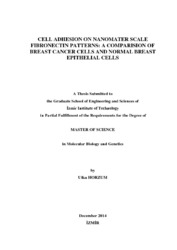Please use this identifier to cite or link to this item:
https://hdl.handle.net/11147/4295| Title: | Cell Adhesion on Nanomater Scale Fibronectin Patterns: a Comparision of Breast Cancer Cells and Normal Breast Epithelial Cells | Other Titles: | Nanometre Ölçeğinde Fibronektin Desenleri Üzerinde Hücre Yapışması: Meme Kanseri Hücreleri ve Normal Meme Epitel Hücrelerinin Karşılaştırılması | Authors: | Horzum, Utku | Advisors: | Pesen Okvur, Devrim | Keywords: | Biotechnology | Publisher: | Izmir Institute of Technology | Source: | Horzum, U. (2014). Cell adhesion on nanomater scale fibronectin patterns: A comparision of breast cancer cells and normal breast epithelial cells. Unpublished master's thesis, İzmir Institute of Technology, İzmir, Turkey | Abstract: | Cell adhesion to extracellular matrix is an important process for both health and disease states. Surface protein patterns are topographically flat, and do not introduce other chemical, topographical or rigidity related functionality and, more importantly, that mimic the organization of the in vivo extracellular matrix are desirable. Previous work showed that vinculin and cytoskeletal organization are modulated by the size and shape of surface nanopatterns. However, a comparative and quantitative analysis on normal and cancerous cell morphology and focal adhesions as a function of micrometer scale spacings of protein nanopatterns was absent. Here, electron beam lithography was used to pattern fibronectin (FN) nanodots with micrometer scale spacings on a K-casein background (single active) on indium tin oxide (ITO) coated glass which, unlike silicon, is transparent and thus suitable for many light microscopy techniques. Exposure times were significantly reduced using the line exposure mode with micrometer scale step sizes. Micrometer scale spacings of 2, 4, 8 microns and gradients between FN nanodots modulated cell adhesion for both breast cancer and normal mammary epithelial cells, through modification of cell area, cell symmetry, actin organization, focal adhesion number, size and circularity under both static and flow conditions. Overall, cell behavior was shown to shift at the apparent threshold of 4 μm spacing. Results showed that there were significant differences in terms of cell adhesion between breast cancer and normal mammary epithelial cells: Breast cancer cells exhibited a more dynamic and flexible adhesion profile than normal mammary epithelial cells. | Description: | Thesis (Master)--Izmir Institute of Technology, Molecular Biology and Genetics, Izmir, 2014 Includes bibliographical references (leaves: 66-72) Text in English; Abstract: Turkish and English xii, 72 leaves Full text release delayed at author's request until 2018.01.26 |
URI: | http://hdl.handle.net/11147/4295 |
| Appears in Collections: | Master Degree / Yüksek Lisans Tezleri |
Files in This Item:
| File | Description | Size | Format | |
|---|---|---|---|---|
| T001337.pdf | MasterThesis | 3.58 MB | Adobe PDF |  View/Open |
CORE Recommender
Page view(s)
338
checked on Mar 31, 2025
Download(s)
110
checked on Mar 31, 2025
Google ScholarTM
Check
Items in GCRIS Repository are protected by copyright, with all rights reserved, unless otherwise indicated.